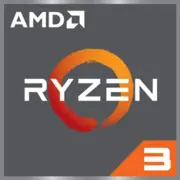AMD Ryzen 3 PRO 2200GE

AMD Ryzen 3 PRO 2200GE: Budget Processor for Office and Multimedia in 2025
April 2025
Despite being released back in 2018, the AMD Ryzen 3 PRO 2200GE remains a popular choice for budget builds due to its energy efficiency and integrated graphics. In this article, we will delve into who this processor is suitable for today, how to use it correctly, and what to consider when building a PC.
1. Key Characteristics: Raven Ridge Architecture and Modest Yet Stable Performance
Architecture and Process Technology
The Ryzen 3 PRO 2200GE is built on the Zen (first generation) microarchitecture code-named Raven Ridge. The manufacturing process is 14nm, which is considered outdated by 2025 standards, but still provides sufficient energy efficiency.
Cores, Threads, and Cache
- 4 cores / 4 threads — a basic option for multitasking in office applications.
- L3 Cache 4 MB — minimal for processors in this class, yet adequate for simple tasks.
Integrated Graphics
Radeon Vega 8 with 8 graphics cores and a clock speed of up to 1100 MHz. This allows for running less demanding games (like CS:GO or Dota 2) at low settings in 720p resolution.
Performance
- Geekbench 6: Single-Core — 697, Multi-Core — 1554.
For comparison, the modern Ryzen 3 8300G (2024) scores around 1800/6000 points, but it is also 3-4 times more expensive.
Key Features
- Low TDP (35W) — suitable for compact systems.
- Support for AMD PRO technologies: Enhanced Security, DASH Management.
2. Compatible Motherboards: AM4 Socket and BIOS Importance
AM4 Socket
The processor uses the AM4 socket, which is still supported by many motherboards. However, in 2025, new AM4 motherboards are no longer being produced — you need to look among leftovers in warehouses or used ones.
Recommended Chipsets
- A320/B350/X370 — basic options, but may require a BIOS update.
- B450/X470 — the better choice, as they support PCIe 3.0 and have more ports.
Examples of Motherboards
- ASRock A320M-HDV (around $50–60) — a minimalist board for office PCs.
- MSI B450 Tomahawk (if you find a new one — $70–90) — an option for upgrades.
Tip: Before purchasing, check if the motherboard supports the Ryzen 3 PRO 2200GE out of the box. Older revisions might require a BIOS update via USB Flashback (if the feature is available).
3. Supported Memory: DDR4 and Dual-Channel Mode
Memory Type
The processor only works with DDR4. There is no DDR5 support, which may seem like a drawback in 2025, but it's not critical for budget tasks.
Recommendations
- Frequency: up to 2933 MHz (officially).
- Configuration: Make sure to use dual-channel mode (2 modules). This will enhance Vega 8 performance by 20–30%.
Examples of Memory Kits
- Kingston HyperX Fury 16GB (2x8GB) 2666MHz — about $45.
- Crucial Ballistix 8GB (2x4GB) 2933MHz — $35.
4. Power Supply: Minimum 400W with Headroom
Power Calculation
With a TDP of 35W and using integrated graphics, the system consumes around 80–100W under load.
Recommendations
- A power supply rated at 400–450W (e.g., EVGA 450 BR, $40–50).
- The emphasis should be more on quality than quantity. Look for models with an 80+ Bronze certification.
Tip: Don't skimp on the PSU! Cheap power supplies can fail and damage components.
5. Pros and Cons: Who Is This Processor Relevant For in 2025?
Pros
- Low price (around $60–80 for a new processor).
- Energy efficiency — suitable for HTPC or mini-PC.
- Presence of Vega 8 graphics — no need to buy a separate graphics card.
Cons
- Only 4 threads — weak multithreading performance.
- No support for PCIe 4.0 and DDR5.
- Outdated process technology — lags behind modern APUs in energy efficiency.
6. Use Cases: Office, Multimedia, and More
Office Tasks
- Document work, browsing (10+ tabs), Zoom conferences.
Multimedia
- Watching 4K video via HDMI 2.0.
- Building an HTPC to connect to a television.
Gaming
- CS:GO: 40–50 FPS on low settings (720p).
- GTA V: 25–30 FPS (720p, minimal graphics).
What Not to Expect
- Video rendering, 3D modeling.
- Modern games like Cyberpunk 2077 or Starfield.
7. Comparison with Competitors: Intel and Modern APUs
Intel Core i3-8100
- Similar performance, but with no integrated graphics on the level of Vega 8. Price used — $50–60.
Ryzen 5 2400G
- 4 cores / 8 threads + Vega 11. On the second-hand market — around $90. The best choice if slightly higher performance is needed.
Ryzen 3 8300G (2024)
- Zen 4, RDNA 3 graphics, DDR5. Priced at $150–170, but offers 2–3 times more FPS in games.
8. Practical Tips for Building
1. SSD is a must — even a cheap Kingston A400 (240GB, $25) will speed up the system.
2. Case with ventilation — for example, Cooler Master MasterBox Q300L ($50).
3. Update your BIOS — this can be done even without a processor if the board supports USB Flashback.
4. Windows Optimization — disable unnecessary background processes to save resources.
9. Final Verdict: Who Should Consider the Ryzen 3 PRO 2200GE in 2025?
This processor should only be considered in two cases:
1. Ultra-budget build — when trying to fit within $200–250 for the whole PC.
2. Upgrading an old system — if you already have an AM4 motherboard and DDR4.
Alternative: If your budget allows to spend $300–400, it’s better to choose the Ryzen 5 5600G or Intel Core i3-12100 — they will provide better future-proofing.
Conclusion: Ryzen 3 PRO 2200GE is a “workhorse” for basic tasks. It is outdated but still lives on due to its low price and minimal cooling requirements.
Basic
CPU Specifications
Memory Specifications
GPU Specifications
Benchmarks
Compared to Other CPU
Share in social media
Or Link To Us
<a href="https://cputronic.com/en/cpu/amd-ryzen-3-pro-2200ge" target="_blank">AMD Ryzen 3 PRO 2200GE</a>